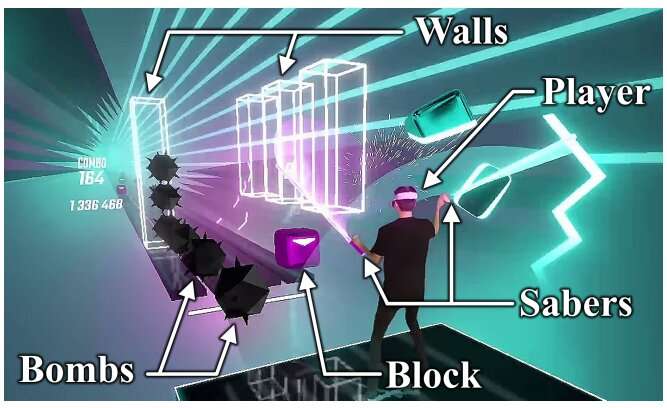Interactive objects in Beat Saber game. Credit: arXiv (2023). DOI: 10.48550/arxiv.2302.08927
A team of computer scientists from UC Berkeley, RWTH Aachen and Unanimous AI, has found that users moving around virtually in the metaverse can be identified using nothing more than data received from head and hand sensors. The group has been studying privacy issues regarding users engaging with virtual reality ecosystems and has found that makers of VR games can easily identify who is involved by analyzing head and hand motion data. They published a paper on the arXiv preprint server.
The metaverse is a term that has been created to describe a virtual reality space where users can interact with one another in various ways. To enter and engage in the metaverse, users don 3D headsets that cover their eyes, allowing them to view what is going on around them in the virtual world. Other hardware includes hand sensors that allow users to interact with other people and virtual objects.
As the metaverse has grown more sophisticated in recent years, the experience has become more immersive—sometimes to the point that people forget that they are not really there. This has led many in the community to wonder about their privacy as they interact in the metaverse. Prior efforts to learn more about privacy in the metaverse have shown that there is little if any privacy—virtually all activity can be traced back to the user. In this new effort, the team in California has found a novel way to trace the identities of users who visit a given virtual world: studying body movements.
The researchers recruited 50,000 volunteers and monitored their activities while they played the VR game Beat Saber, which requires nearly constant movement. The researchers collected 2.5 million data recordings from the volunteers and then used that data to teach an AI system to recognize slight differences in the ways people moved when doing nearly the same things.
They found it was capable of identifying a unique individual with 94% accuracy after training on just 100 seconds of motion data. The research team also found that study of motion data allowed them not only to identify a given individual, but to reveal which was their dominant hand, their height, and in some instances, their gender.
More information: Vivek Nair et al, Unique Identification of 50,000+ Virtual Reality Users from Head & Hand Motion Data, arXiv (2023). DOI: 10.48550/arxiv.2302.08927
Journal information: arXiv
© 2023 Science X Network
























